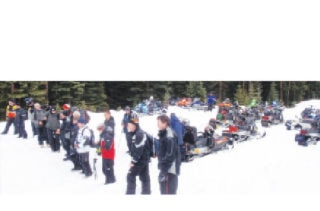The weekend started with an all day classroom session that saw the participants learn how different types of snow conditions develop into what could start an avalanche, how to assess the stability and types of terrain, and finding a route through it. The students were taught how to do risk analysis, using tools such as Canada Avalanche Centre bulletins (avalanche.ca), the Trip Planner, and Avaluator V2.0™. The day finished up with a discussion on types of equipment that would allow one to perform a rescue; specifically a beacon, probe, and shovel. Students found that the newest digital beacons have three antennas verses two antenna, and that the older analog beacons should be replaced. Probes should be sturdy and the wires checked for wear. Shovels should be metal and carried inside your pack. Students learned the best chance for survival is to avoid potential avalanche terrain, to wear the beacon on your body in the provided harness, and to always wear your pack.
The second day was hands on training in the rain on Rabbit Mountain. The terrible conditions did allow students to see some of what was taught in the classroom as there were multiple small avalanches along Coalmont Road and signs of potential avalanches along the trail. Students practiced single beacon search, probing and shovelling techniques, and progressed to multiple beacon searches. They also practiced line probing in the event that someone who wasn’t wearing a beacon was buried. Students were then shown how to dig a snow profile test pit and look at how all the different layers and snow types have developed over the season. The test pits showed the weak layers that caused forecasters to issue a SPAW (Special Public Avalanche Warning) the weekend of Jan 22-23, 2011. (They are not made very often)
The day finished up performing very realistic scenarios that the attendees will hopefully never encounter. The first was a multiple burial of 5 snowmobilers that all attendees participated in. It showed the challenges and advantages of having many searchers. In just under 10 minutes, all ‘buried’ people were found and dug out. Students then split up into two teams and made up a scenario for the other team. Teams were pretty mischievous, burying 2 beacons on top of each other, observers leaving their beacons on, a beacon left on in the cabin, and one buried 4’ deep. It made the students use the knowledge they had gained, and was a great way to end the day.
Everyone agreed that this training was invaluable. Some comments from long time sledders were “with what I know now, I’m surprised that I never got hit by an avalanche in the past” and “ this course should be mandatory for any snowmobiler”.
PGSAR would like to thank Reichert’s Sales and Service for organizing this course, and Carol Savage, Tracy and Kathy Senio, Brad Atkins, and Rob Milne for their great instruction.
For more info on Avalanches visit www.avalanche.ca
